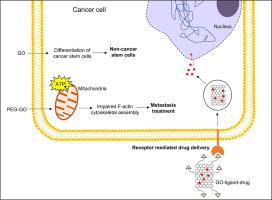Advanced Drug Delivery Reviews ( IF 16.1 ) Pub Date : 2022-07-29 , DOI: 10.1016/j.addr.2022.114467 Shadi Rahimi 1 , Yanyan Chen 1 , Mohsen Zareian 2 , Santosh Pandit 1 , Ivan Mijakovic 3

|
Despite significant advances in early detection and personalized treatment, cancer is still among the leading causes of death globally. One of the possible anticancer approaches that is presently receiving a lot of attention is the development of nanocarriers capable of specific and efficient delivery of anticancer drugs. Graphene-based materials are promising nanocarriers in this respect, due to their high drug loading capacity and biocompatibility. In this review, we present an overview on the interactions of graphene-based materials with normal mammalian cells at the molecular level as well as cellular and subcellular levels, including plasma membrane, cytoskeleton, and membrane-bound organelles such as lysosomes, mitochondria, nucleus, endoplasmic reticulum, and peroxisome. In parallel, we assemble the knowledge about the interactions of graphene-based materials with cancerous cells, that are considered as the potential applications of these materials for cancer therapy including metastasis treatment, targeted drug delivery, and differentiation to non-cancer stem cells. We highlight the influence of key parameters, such as the size and surface chemistry of graphene-based materials that govern the efficiency of internalization and biocompatibility of these particles in vitro and in vivo. Finally, this review aims to correlate the key parameters of graphene-based nanomaterials specially graphene oxide, such as size and surface modifications, to their interactions with the cancerous and non-cancerous cells for designing and engineering them for bio-applications and especially for therapeutic purposes.
中文翻译:

石墨烯基材料与癌细胞和非癌细胞的细胞和亚细胞相互作用
尽管在早期检测和个性化治疗方面取得了重大进展,但癌症仍然是全球主要的死亡原因之一。目前受到广泛关注的一种可能的抗癌方法是开发能够特异性和有效地递送抗癌药物的纳米载体。基于石墨烯的材料在这方面是有前途的纳米载体,因为它们具有高载药能力和生物相容性。在这篇综述中,我们概述了石墨烯材料与正常哺乳动物细胞在分子水平以及细胞和亚细胞水平上的相互作用,包括质膜、细胞骨架和膜结合的细胞器,如溶酶体、线粒体、细胞核、内质网和过氧化物酶体。在平行下,我们收集了有关石墨烯材料与癌细胞相互作用的知识,这些知识被认为是这些材料在癌症治疗中的潜在应用,包括转移治疗、靶向药物递送和向非癌症干细胞的分化。我们强调了关键参数的影响,例如石墨烯基材料的尺寸和表面化学,这些参数控制着这些粒子的内化效率和生物相容性体外和体内。最后,本综述旨在将基于石墨烯的纳米材料(特别是氧化石墨烯)的关键参数(例如尺寸和表面改性)与它们与癌细胞和非癌细胞的相互作用联系起来,以设计和工程化它们用于生物应用,特别是用于治疗目的。



























 京公网安备 11010802027423号
京公网安备 11010802027423号